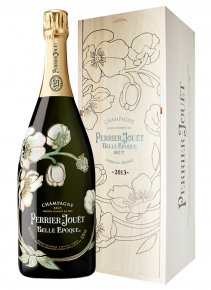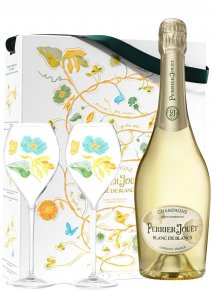Perrier-Jouët champagne

Perrier-Jouët has been synonymous with refinement and innovation since its founding in 1811 by Pierre-Nicolas Perrier and Adèle Jouët. The house is distinguished by its unique, floral style, embodied in every bottle it produces.
The Perrier-Jouët style
What makes Perrier-Jouët famous is undoubtedly its inimitable style. Made primarily from Chardonnay grapes, the house's champagnes are distinguished by their floral aromas, freshness, and elegance. Each cuvée is a work of art, designed to offer a unique sensory experience. The Perrier-Jouët style is characterized by floral delicacy and subtle complexity, reflecting expertise passed down from cellar master to cellar master.
The winemaking
The creation of a Perrier-Jouët cuvée begins in the vineyard, which is 99.2% classified on the cru scale. The grapes are harvested by hand and gently pressed to preserve their qualities. The first fermentation transforms the grape juice into clear wine. Séverine Frerson, Cellar Master, then steps in to blend the wines. Drawing on her in-depth knowledge of the terroirs, she selects the crus that will best express the style of each cuvée.
The role of the Cellar Master
Since 2020, Séverine Frerson has been in charge of winemaking at Perrier-Jouët. The first woman to hold this position in the history of the house, she continues the tradition while bringing a touch of modernity. Her mission: to preserve the identity of each cuvée while exploring new expressions of the Champagne terroir.
Perrier-Jouët champagne prices
The Perrier-Jouët range offers champagnes for all occasions. Perrier-Jouët Grand Brut, for example, is affordable while offering exceptional quality. For more prestigious occasions, the Belle Époque cuvée stands out for its elegance and complexity, justifying its higher price. Whether you are looking for a champagne for an aperitif or a celebration, Perrier-Jouët offers options to suit all budgets.
A heritage of premier Brut champagne
In 1846, Perrier-Jouët revolutionized the world of champagne by creating the first brut champagne cuvée, responding to the English preference for drier champagnes. This innovation not only defined the house's style but also marked the history of champagne.
The different cuvées of Perrier-Jouët
Perrier-Jouët Blanc de Blancs
Launched in 2017, the Blanc de Blancs cuvée showcases Chardonnay in its purest form. The vineyards of the Côte des Blancs produce grapes with distinctive floral and mineral nuances. This cuvée embodies the essence of the house's expertise and is ideal for lovers of refined and fresh champagnes.
Perrier-Jouët Belle Époque
The Belle Époque cuvée, introduced in 1964, is renowned for its iconic bottle adorned with Japanese anemones. This vintage champagne, produced only in the best years, offers complexity and elegance that make it the perfect choice for special occasions.
| Vintages of the Belle Époque cuvée | ||
|---|---|---|
| 1964 | 1966 | 1969 |
| 1970 | 1971 | 1973 |
| 1975 | 1976 | 1978 |
| 1979 | 1981 | 1982 |
| 1983 | 1985 | 1986 |
| 1988 | 1989 | 1990 |
| 1993 | 1995 | 1996 |
| 1998 | 1999 | 2000 |
| 2002 | 2004 | 2006 |
| 2007 | 2008 | 2011 |
| 2012 | 2013 | 2014 |
| 2015 | ||
Rosé champagnes
Perrier-Jouët's rosé cuvées, such as Blason Rosé and Belle Époque Rosé, are distinguished by their delicate pink hue, achieved through a blend of Pinot Noir wines. These champagnes offer complex and seductive aromatic profiles, perfect for accompanying a variety of dishes, from salmon to duck breast.
Perrier-Jouët Champagnes : good to know
| 🔢 Available products count | 14 |
|---|---|
| 🎨 Colour | White champagne, Rosé champagne |
| 🍾 Format | Bottle, Magnum |
| ↕️ Dosage | Champagne brut |
| 🍇 Cépage | Pinot noir, Pinot meunier, Chardonnay |
| 📍 Terroirs | Montagne de reims, Cote des blancs, Vallée de la marne, Cote des bar |
| ⭐ Vintage | Non vintage champagne, Vintage 2016, Annata 2013 |
| 📦 Packaging | Champagne and flutes box, Champagne in a box, Champagne in a wooden case |
| 💡 Type de champagne | Blanc de blancs |















